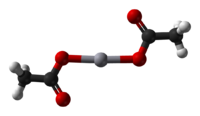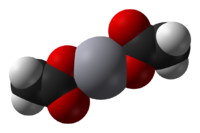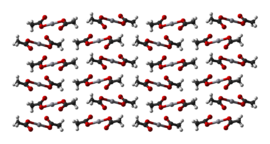- Mercury(II) acetate
-
Mercury(II) acetate 

 Other namesmercuric acetate
Other namesmercuric acetate
mercuriacetateIdentifiers CAS number 1600-27-7 
ChemSpider 14599 
UNII R0G1MCT8Y5 
ChEBI CHEBI:33211 
Jmol-3D images Image 1 - [Hg+2].[O-]C(=O)C.[O-]C(=O)C
Properties Molecular formula C4H6O4Hg Molar mass 318.70 g/mol Appearance white crystals Density 3.27 g/cm³, solid Melting point 179°C (decomposes)
Solubility in water 25 g/100 mL (10°C) Solubility soluble in alcohol Hazards NFPA 704  acetate (verify) (what is:
acetate (verify) (what is:  /
/ ?)
?)
Except where noted otherwise, data are given for materials in their standard state (at 25 °C, 100 kPa)Infobox references Mercury(II) acetate is the chemical compound with the formula Hg(O2CCH3)2. Commonly abbreviated Hg(OAc)2, this compound is employed as a reagent to generate organomercury compounds from unsaturated organic precursors.
Structure
Mercury(II) acetate is a crystalline solid consisting of isolated Hg(OAc)2 molecules with Hg-O distances of 2.07 Å. Three long, weak intermolecular Hg···O bonds of about 2.75 Å are also present, resulting in a slightly distorted square pyramidal coordination geometry at Hg.[1]


Reactions
Arenes undergo "mercuration" upon treatment with Hg(OAc)2. The one acetate group that remains on mercury can be displaced by chloride:[2]
- C6H5OH + Hg(OAc)2 → C6H4(OH)-2-HgOAc + HOAc
- C6H4(OH)-2-HgOAc + NaCl → C6H4(OH)-2-HgCl + NaOAc
The Hg2+ center binds to alkenes, inducing the addition of hydroxide and alkoxide. For example, treatment of methylacrylate with mercuric acetate in methanol gives an α-mercuri ester:[3]
- Hg(OAc)2 + CH2=CHCO2CH3 + CH3OH → CH3OCH2CH(HgOAc)CO2CH3 + HOAc
Mercury(II) has a high affinity for sulfur ligands. Hg(OAc)2 can be used as a reagent to remove the acetamidomethyl protecting group, which is used to "protect" thiol groups in organic synthesis. Similarly Hg(OAc)2 is a standard reagent to convert thiocarbonate esters into dithiocarbonates:
- (RS)2C=S + H2O + Hg(OAc)2 → (RS)2C=O + HgS + 2 HOAc
References
- ^ R. Allmann (1973). Z. Kristallogr., Kristallgeom., Kristallphys., Kristallchem. 138: 366–373.
- ^ Whitmore, F. C.; Hanson, E. R. "o-Chloromercuriphenol" Organic Syntheses, Collected Volume 1, p.161 (1941).http://www.orgsyn.org/orgsyn/orgsyn/prepContent.asp?prep=CV1P0161
- ^ Carter, H. E.; West, H. D. “dl-Serine” Organic Syntheses, Collected Volume 3, p.774 (1955). http://www.orgsyn.org/orgsyn/orgsyn/prepContent.asp?prep=CV3P0774
Mercury compounds Categories:- Acetates
- Mercury compounds
- Inorganic compound stubs
Wikimedia Foundation. 2010.

